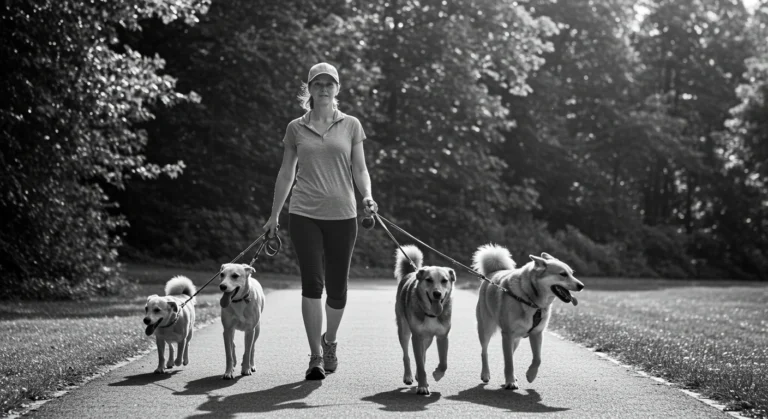Discover 6 rewarding dog walking jobs to start today! From freelance services to franchise opportunities, learn how to turn your love for dogs into a profitable career in 2025.
Table of Contents
Did you know that the pet care industry is expected to reach $350 billion globally by 2027, with dog walking services representing one of the fastest-growing segments? If you’re passionate about dogs and looking for a flexible career opportunity, dog walking jobs might be the perfect fit for you. Whether you’re seeking a side hustle or a full-time career change, the world of professional dog walking offers numerous pathways to success.
When I first started walking dogs in my neighborhood in Austin, Texas, I had no idea it would become such a rewarding career. What began as helping elderly neighbors with their pets quickly evolved into a thriving business that allowed me to work with dozens of furry companions while maintaining the flexibility I craved. The joy of seeing a dog’s excitement when you arrive for their walk is truly priceless.
In this comprehensive guide, we’ll explore six distinct dog walking jobs opportunities, from freelance services to franchise options, helping you understand which path aligns best with your goals, schedule, and entrepreneurial spirit. We’ll cover everything from getting started to maximizing your earning potential in this growing industry.
1. Freelance Dog Walking Services

Building Your Independent Dog Walking Business
Starting as a freelance dog walker represents the most accessible entry point into dog walking jobs. This approach offers complete control over your schedule, pricing, and client relationships while requiring minimal startup costs.
Getting Started as a Freelance Dog Walker:
- Obtain necessary business licenses and insurance
- Create professional marketing materials
- Develop a pricing structure competitive with your local market
- Build a client base through referrals and local advertising
Essential Requirements:
- Liability insurance (typically $100-300 annually)
- Business license (varies by location)
- Basic first aid knowledge for pets
- Physical fitness and stamina
- Reliable transportation
The average freelance dog walker earns $15-25 per walk, with experienced professionals in metropolitan areas commanding $30-50 per hour. Success depends largely on building a loyal client base and maintaining consistent, professional service.
Marketing Your Freelance Services
Successful freelance dog walkers leverage multiple marketing channels to attract clients. Social media platforms like Instagram and Facebook allow you to showcase happy dogs in action, while neighborhood apps like Nextdoor facilitate local connections. Professional networking with veterinarians, pet stores, and grooming services can generate valuable referrals.
Word-of-mouth marketing remains the most powerful tool in this industry. Exceptional service, reliability, and genuine care for pets naturally lead to client referrals and positive online reviews, which are crucial for business growth.
2. App-Based Dog Walking Platforms
Leveraging Technology for Dog Walking Jobs
Modern technology has revolutionized dog walking jobs through dedicated platforms that connect pet owners with professional walkers. Companies like Rover, Wag, and Care.com have created ecosystems where independent contractors can access a steady stream of clients while benefiting from established brand recognition and marketing support.
Popular App-Based Platforms:
- Rover: The largest platform with over 500,000 active walkers
- Wag: Focuses on on-demand services with rapid booking capabilities
- Care.com: Offers comprehensive pet care services beyond just walking
- Fetch! Pet Care: Regional franchise model with app integration
Platform Benefits:
- Instant access to potential clients
- Built-in payment processing and insurance
- Customer support and conflict resolution
- Marketing and brand recognition
- Flexible scheduling tools
Considerations:
- Platform fees typically range from 15-30% of earnings
- Less control over pricing and policies
- Competition with numerous other walkers
- Dependency on platform algorithms for client matching
Most app-based walkers earn $12-18 per walk after platform fees, though top-rated professionals in high-demand areas can earn significantly more through repeat bookings and premium services.
3. Pet Care Franchise Opportunities
Structured Business Models for Dog Walking Jobs
Franchise opportunities represent a middle ground between independent operation and employment, offering established business models, brand recognition, and ongoing support while maintaining some entrepreneurial control.
Leading Dog Walking Franchise Options:
Fetch! Pet Care
- Initial investment: $49,000-$64,000
- Franchise fee: $39,500
- Territory protection and marketing support
- Comprehensive training program
Camp Bow Wow
- Focus on daycare with walking services
- Initial investment: $250,000-$500,000
- Full-service pet care model
- Established brand with national recognition
Dogtopia
- Premium daycare and walking services
- Initial investment: $350,000-$600,000
- High-end market positioning
- Comprehensive operational support
Franchise Benefits and Considerations
Franchises provide proven business models, marketing support, and operational systems that can accelerate success. However, they require significant initial investment and ongoing royalty payments, typically 5-8% of gross revenue.
The structured approach appeals to entrepreneurs who prefer established systems over developing their own business processes. Franchise owners often achieve faster profitability compared to independent startups, though profit margins may be lower due to ongoing fees.
4. Employment with Pet Care Companies
Traditional Employment in Dog Walking Jobs
Many pet care companies hire employees rather than contractors, offering steady income, benefits, and structured work environments. This option suits individuals who prefer employment stability over entrepreneurial uncertainty.
Types of Pet Care Employers:
- Local pet care companies
- Veterinary clinics offering walking services
- Boarding facilities with exercise programs
- Pet resorts and daycare centers
- Corporate pet care providers
Employment Benefits:
- Steady wages ($12-18 per hour typically)
- Potential for benefits (health insurance, paid time off)
- Structured schedules and expectations
- Training and professional development
- Less business risk and responsibility
Career Advancement Opportunities
Employment with established pet care companies often provides clear advancement paths. Dedicated dog walkers can progress to supervisory roles, training positions, or management opportunities. Some companies offer tuition assistance for veterinary or animal behavior education, creating pathways to higher-level positions within the pet care industry.
5. Specialized Dog Walking Services
Niche Markets within Dog Walking Jobs
Specialized services command premium pricing by addressing specific client needs that general dog walkers cannot meet. These niches require additional training or certification but offer higher earning potential and reduced competition.
High-Demand Specializations:
Senior Dog Care
- Gentle exercise programs for aging pets
- Medication administration
- Mobility assistance and monitoring
- Premium pricing: $25-40 per walk
Behavioral Modification Walking
- Working with reactive or anxious dogs
- Structured training during walks
- Collaboration with professional trainers
- Premium pricing: $30-50 per walk
Adventure Walking Services
- Hiking and outdoor exploration
- Multiple-dog pack walks
- Photography services during walks
- Premium pricing: $35-60 per session
Medical Support Walking
- Post-surgery rehabilitation walks
- Diabetic dog monitoring
- Medication administration
- Premium pricing: $40-75 per walk
Developing Specialized Skills
Specialization requires investment in education and certification. Organizations like the Certification Council for Professional Dog Trainers (CCPDT) and the National Association of Professional Pet Sitters (NAPPS) offer relevant training programs. These credentials enhance credibility and justify premium pricing.
Successful specialized walkers often collaborate with veterinarians, trainers, and behaviorists to provide comprehensive care. This networking approach generates referrals and establishes professional credibility within the pet care community.
6. Group and Pack Walking Services
Scaling Your Dog Walking Business
Group walking services allow experienced professionals to maximize earning potential by caring for multiple dogs simultaneously. This model requires advanced skills in dog behavior and pack management but can significantly increase hourly earnings.
Pack Walking Benefits:
- Higher earnings per hour ($50-100+ per session)
- Efficient use of time and resources
- Social benefits for dogs
- Reduced per-client costs
Essential Pack Walking Skills:
- Advanced dog behavior knowledge
- Crowd control and safety management
- Emergency response capabilities
- Proper equipment for multiple dogs
Safety Considerations:
- Maximum recommended pack size: 4-6 dogs
- Careful screening and compatibility assessment
- Additional insurance coverage requirements
- Proper equipment for group management
Building a Pack Walking Business
Successful pack walking requires careful client selection and gradual skill development. Start with two compatible dogs and gradually expand as experience and confidence grow. Establish clear policies regarding dog compatibility, vaccination requirements, and emergency procedures.
Location selection is crucial for pack walking success. Large, secure areas with minimal distractions provide optimal environments for group activities. Many pack walkers develop relationships with dog parks, private facilities, or rural properties to ensure safe, controlled environments.
Essential Equipment and Safety Considerations
Professional Equipment for Dog Walking Jobs
Professional dog walkers require reliable, high-quality equipment to ensure safety and efficiency. Investment in proper gear demonstrates professionalism and protects both walker and dogs.
Essential Equipment List:
- Professional-grade leashes and harnesses
- Waste disposal supplies and carriers
- First aid kit for pets and humans
- Emergency contact information system
- Weather-appropriate gear
- GPS tracking and communication devices
Safety Equipment:
- Reflective clothing and LED attachments
- Emergency whistle
- Pepper spray or deterrent (where legal)
- Emergency contact cards
- Basic medical supplies
Insurance and Legal Considerations
Professional liability insurance is essential for all dog walking jobs, regardless of business structure. Coverage should include:
- General liability protection
- Care, custody, and control coverage
- Professional liability insurance
- Bonding protection
Legal requirements vary by location but commonly include business licenses, tax registration, and compliance with local pet care regulations. Some municipalities require specific permits for dog walking businesses or limit the number of dogs that can be walked simultaneously.
Building Your Client Base and Marketing Strategies
Effective Marketing for Dog Walking Jobs
Successful dog walking businesses require consistent marketing efforts to attract and retain clients. Modern pet owners research services online, making digital presence crucial for business growth.
Digital Marketing Strategies:
- Professional website with service descriptions and pricing
- Social media presence showcasing happy dogs
- Google Business Profile optimization
- Online review management
- Email marketing to existing clients
Local Marketing Approaches:
- Partnerships with veterinary clinics
- Collaboration with pet stores and groomers
- Community event participation
- Neighborhood newsletter advertising
- Direct mail campaigns in target areas
Client Retention Strategies
Retaining existing clients costs significantly less than acquiring new ones. Successful dog walkers implement systematic approaches to client satisfaction:
Retention Best Practices:
- Consistent communication and updates
- Photo and video sharing during walks
- Flexible scheduling accommodation
- Personalized service for each pet
- Proactive health and behavior observations
- Regular service quality assessments
Building strong relationships with both pets and owners creates emotional connections that transcend price competition. Pet owners who trust their walker’s judgment and care are less likely to switch services based solely on cost considerations.
Pricing Strategies and Earning Potential
Maximizing Income in Dog Walking Jobs
Pricing strategy significantly impacts both client acquisition and long-term profitability. Successful dog walkers balance competitive rates with fair compensation for their time and expertise.
Factors Influencing Pricing:
- Geographic location and market rates
- Service duration and complexity
- Number of dogs per walk
- Additional services offered
- Walker experience and credentials
- Time of day and scheduling flexibility
Average Pricing Ranges by Market:
- Urban areas: $20-40 per walk
- Suburban areas: $15-25 per walk
- Rural areas: $12-20 per walk
- Premium services: $30-60 per walk
- Group walks: $15-25 per dog
Value-Added Services
Successful dog walking businesses often expand beyond basic walking services to increase revenue and client value:
Additional Service Options:
- Pet sitting and overnight care
- Basic grooming and cleaning
- Medication administration
- Training reinforcement during walks
- Pet transportation services
- Plant watering and home security checks
These supplementary services can double or triple income from existing clients while strengthening business relationships and increasing client retention.
Common Challenges and How to Overcome Them
Navigating Obstacles in Dog Walking Jobs
Professional dog walking presents unique challenges that require practical solutions and ongoing adaptation. Understanding common obstacles helps new walkers prepare effectively.
Typical Challenges:
Weather Dependency
- Solution: Invest in weather-appropriate gear and develop indoor alternatives
- Maintain flexible scheduling policies
- Communicate clearly about weather-related cancellations
Physical Demands
- Solution: Gradually build fitness and stamina
- Use proper body mechanics and equipment
- Limit simultaneous dog numbers initially
- Consider specialized equipment for easier handling
Client Communication
- Solution: Establish clear communication protocols
- Use technology for updates and scheduling
- Set realistic expectations from the beginning
- Document all services and observations
Income Fluctuation
- Solution: Diversify client base across different demographics
- Offer multiple service types
- Build emergency fund for slow periods
- Develop consistent marketing efforts
Professional Development and Growth
Continuous learning and skill development distinguish successful dog walking professionals from casual providers. Investment in education and certification demonstrates commitment to excellence and justifies premium pricing.
Professional Development Opportunities:
- Pet first aid and CPR certification
- Dog behavior and training courses
- Business management and marketing education
- Networking with veterinary professionals
- Industry conference attendance
- Online continuing education programs
When to Consult Veterinary Professionals
Recognizing Medical Concerns During Dog Walking Jobs
Professional dog walkers serve as important observers of pet health and behavior changes. Knowing when to recommend veterinary consultation protects pets and demonstrates professional responsibility.
Immediate Veterinary Situations:
- Difficulty breathing or excessive panting
- Loss of consciousness or collapse
- Severe injury or bleeding
- Signs of heat exhaustion
- Aggressive behavior changes
- Visible pain or distress
Non-Emergency Concerns to Report:
- Changes in walking pace or stamina
- Appetite or water consumption changes
- Behavioral modifications
- Limping or mobility issues
- Skin conditions or excessive scratching
- Digestive irregularities
Professional walkers should never diagnose medical conditions but should promptly communicate observations to pet owners and recommend veterinary evaluation when appropriate.
Expert Tips for Success in Dog Walking Jobs
Professional Insights for Dog Walking Excellence
Experienced dog walking professionals share common practices that contribute to business success and client satisfaction.
Top Success Tips:
- Consistency is Key: Maintain reliable schedules and communication patterns to build trust and dependability.
- Documentation Matters: Keep detailed records of each walk, including behavior observations, weather conditions, and any incidents.
- Invest in Quality Equipment: Professional-grade equipment enhances safety and demonstrates commitment to quality service.
- Know Your Limits: Understand your physical and skill limitations to ensure safety for both walker and pets.
- Build Professional Networks: Develop relationships with veterinarians, trainers, and other pet professionals for referrals and support.
- Continuous Learning: Stay updated on pet care best practices, safety protocols, and business management techniques.
- Clear Communication: Establish transparent policies and maintain open dialogue with pet owners about expectations and services.
- Emergency Preparedness: Develop and practice emergency response procedures for various scenarios.
Common Mistakes to Avoid
Learning from others’ mistakes can accelerate professional development and prevent costly errors:
Critical Mistakes to Avoid:
- Inadequate insurance coverage
- Poor client screening processes
- Overcommitting to too many dogs initially
- Neglecting business license requirements
- Insufficient emergency preparedness
- Inconsistent pricing strategies
- Poor communication with pet owners
- Ignoring continuing education opportunities
The Future of Dog Walking Jobs
Industry Trends and Opportunities
The pet care industry continues evolving, creating new opportunities within dog walking jobs. Understanding emerging trends helps professionals position themselves for future success.
Emerging Trends:
- Technology integration for tracking and communication
- Specialized services for senior pets
- Eco-friendly and sustainable practices
- Corporate pet care benefits programs
- Integration with veterinary telemedicine
- Adventure and fitness-focused services
Market Growth Indicators:
- Increasing pet ownership rates
- Growing demand for premium pet services
- Corporate employee benefits expansion
- Aging pet population requiring specialized care
- Urban population growth creating service demand
The industry’s future looks promising for dedicated professionals who adapt to changing client needs and embrace technological advancements while maintaining the personal touch that makes dog walking services valuable.
For more expert pet care tips and product recommendations, visit BlithePet.com — your trusted source for pet wellness.
Dog Walking Service Types Comparison
| Service Type | Average Cost | Duration | Best For | Booking Method | Special Features |
|---|---|---|---|---|---|
| Individual Walk | $20-35 | 30-60 minutes | Anxious or reactive dogs | Direct booking | One-on-one attention, customizable route |
| Group Walk | $15-25 | 45-90 minutes | Social dogs needing exercise | Scheduled groups | Socialization, cost-effective |
| App-Based Service | $12-25 | 20-60 minutes | Busy professionals | Mobile app | GPS tracking, photo updates |
| Premium Adventure | $40-75 | 2-4 hours | High-energy breeds | Advance reservation | Hiking, beach walks, photography |
| Senior Dog Care | $25-45 | 20-45 minutes | Elderly or mobility-limited dogs | Direct consultation | Gentle pace, health monitoring |
| Training Walks | $35-60 | 45-75 minutes | Dogs needing behavior work | Trainer referral | Leash training, socialization practice |
Dog Walking Safety Guidelines by Weather Conditions
| Weather Condition | Temperature Range | Safety Precautions | Walk Duration | Equipment Needed | Warning Signs |
|---|---|---|---|---|---|
| Hot Weather | 80°F+ (27°C+) | Early morning/evening walks, avoid hot pavement | 15-30 minutes | Water, cooling vest, paw protection | Excessive panting, drooling, lethargy |
| Cold Weather | Below 32°F (0°C) | Dog coats for short-haired breeds, check paws | 20-45 minutes | Dog jacket, paw balm, towels | Shivering, lifting paws, seeking warmth |
| Rainy Conditions | Any temperature | Waterproof gear, avoid deep puddles | 20-40 minutes | Rain coat, umbrellas, extra towels | Reluctance to walk, seeking shelter |
| Snow/Ice | Below 40°F (4°C) | Salt-safe paws, slower pace, bright visibility | 15-30 minutes | Booties, reflective gear, ice cleats | Ice accumulation between toes, limping |
| High Humidity | 80°F+ with 70% humidity | Frequent water breaks, shade rest stops | 20-35 minutes | Extra water, cooling mat, fan | Heavy breathing, excessive thirst |
| Windy Conditions | Any temperature | Secure leash grip, avoid debris areas | 25-40 minutes | Sturdy leash, eye protection | Difficulty walking, debris in eyes/ears |
Dog Walking Business Pricing Structure Guide
| Service Category | Urban Areas | Suburban Areas | Rural Areas | Premium Add-ons | Frequency Discounts |
|---|---|---|---|---|---|
| Standard 30-min Walk | $25-40 | $18-28 | $15-22 | GPS tracking (+$5) | Daily: 10-15% off |
| Extended 60-min Walk | $40-60 | $30-45 | $25-35 | Photo updates (+$3) | Weekly package: 5-10% off |
| Group Walk (per dog) | $20-30 | $15-25 | $12-18 | Training focus (+$10) | Multiple dogs: 20% off 2nd+ |
| Puppy Walks (15-20 min) | $18-25 | $15-20 | $12-18 | Potty training (+$5) | 3x daily: 15% off total |
| Senior Dog Care | $30-45 | $25-35 | $20-30 | Medication admin (+$8) | Monthly plan: 12% off |
| Holiday/Emergency | $45-70 | $35-50 | $30-40 | Same-day booking (+$15) | No discounts on emergency rates |
Frequently Asked Questions
Conclusion
Dog walking jobs offer diverse pathways to meaningful work with animals while providing valuable services to pet owners. Whether you choose freelance independence, app-based flexibility, franchise support, traditional employment, specialized services, or pack walking, success depends on professionalism, dedication, and genuine care for animals.
The pet care industry’s continued growth ensures strong demand for quality dog walking services. By following the strategies outlined in this guide, investing in proper equipment and insurance, and maintaining high service standards, you can build a rewarding career that combines passion for animals with financial success.
Starting your dog walking journey doesn’t require massive investment or extensive experience – just genuine love for dogs, commitment to professional standards, and willingness to learn and adapt. The six paths we’ve explored offer options for various skill levels, investment capabilities, and career goals.
Remember that successful dog walking jobs extend beyond simple exercise provision. Today’s professional dog walkers serve as pet health observers, behavior monitors, and trusted caregivers who provide peace of mind to busy pet owners. This responsibility makes the work both challenging and deeply rewarding.
Have a similar experience with your pet or dog walking business? Share it in the comments below! Don’t forget to check out our other helpful guides at BlithePet.com for more expert pet care advice and professional development resources.






